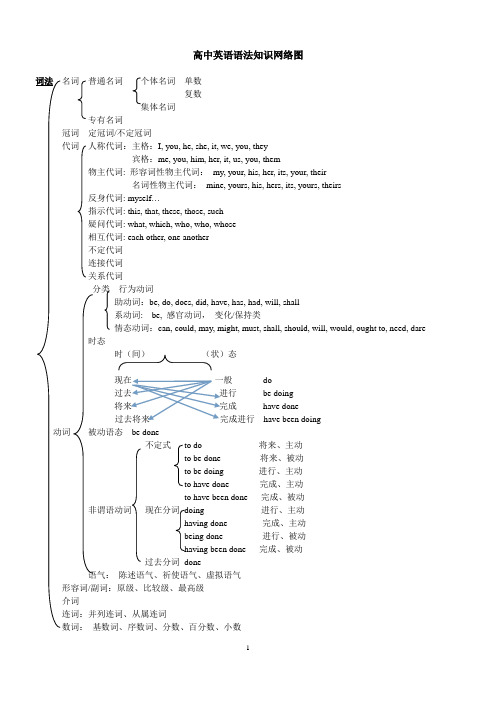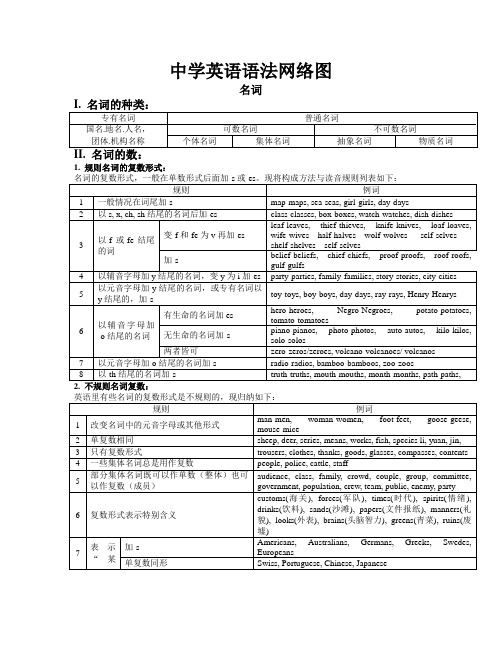语法网络图
- 格式:doc
- 大小:401.00 KB
- 文档页数:17

初中英语语法大全语法网络图一.名词II. 名词的数:1. 规则名词的复数形式:名词的复数形式,一般在单数形式后面加-s或-es。
现将构成方法与读音规则列表如下:III. 名词的所有格:名词在句中表示所有关系的语法形式叫做名词所有格。
所有格分两种:一是名词词尾加’s 构成,二是由介词of加名词构成。
前者多表示有生命的东西,后者多表示无生命的东西。
3. of所有格的用法:用于无生命的东西:the legs of the chair, the cover of the book用于有生命的东西,尤其是有较长定语时:the classrooms of the first-year students 用于名词化的词:the struggle of the oppressed二.冠词冠词分为不定冠词(a, an),定冠词(the),和零冠词。
三.代词:II. 不定代词用法注意点:1. one, some与any:1) one可以泛指任何人,也可特指,复数为ones。
some多用于肯定句,any多用于疑问句和否定句。
One should learn to think of others.Have you any bookmarks? No, I don’t have any bookmarks.I have some questions to ask.2) some可用于疑问句中,表示盼望得到肯定的答复,或者表示建议,请求等。
Would you like some bananas?Could you give me some money?3) some 和any修饰可数名词单数时,some表示某个,any表示任何一个。
I have read this article in some magazine.Please correct the mistakes, if any.4) some和数词连用表示“大约”,any可与比较级连用表示程度。

高中英语语法知识网络图名词普通名词单数复数集体名词专有名词冠词定冠词/不定冠词代词人称代词:主格:I, you, he, she, it, we, you, they宾格:me, you, him, her, it, us, you, them物主代词: 形容词性物主代词:my, your, his, her, its, your, their名词性物主代词:mine, yours, his, hers, its, yours, theirs反身代词: myself…指示代词: this, that, these, those, such疑问代词: what, which, who, who, whose相互代词: each other, one another不定代词连接代词关系代词分类行为动词助动词:be, do, does, did, have, has, had, will, shall系动词: be, 感官动词,变化/保持类情态动词:can, could, may, might, must, shall, should, will, would, ought to, need, dare 时态时(间)(状)态现在一般do过去进行be doing将来完成have done过去将来完成进行have been doing被动语态be done不定式to do 将来、主动to be done 将来、被动to be doing 进行、主动to have done 完成、主动to have been done 完成、被动非谓语动词现在分词doing 进行、主动having done 完成、主动being done 进行、被动having been done 完成、被动过去分词done语气:陈述语气、祈使语气、虚拟语气形容词/副词:原级、比较级、最高级介词连词:并列连词、从属连词数词:基数词、序数词、分数、百分数、小数句子成分:主谓宾定状补表简单句SV 主+不及物动词+状语She came with her teacher./ My head aches.SVP 主+系动词+表语She is happy.句法SVO 主+及物动词+宾语She likes English.SVOO 主+及物动词+间接宾语+直接宾语She gave John a book.She bought a book for me.SVOC 主+及物动词+宾语+宾补(名词、形容词、介词短语、分词、不定式等)She made her mother angry.The teacher asked me to read the passage.句子结构并列句并列连词and, but, so, or等名词性从句种类主语从句宾语从句表语从句同位语从句连词 1. that 无意义,不做成分2. whether, if, as if, as though 有意义,不做成分3. what, who, whom, which, when, where, why 有意义,做成分复合句 1. 先行词(,)+ 引导词+ 从句关系代词关系副词定语从句人物时间: when主语:who which 地点: wherethat 原因: why宾语:whom which定语:whose whose2. 先行词(,)+介词+ which/whom + 从句先行词,+ some/both/one of which/whom + 从句1. 时间when,while, as,before, after,till,until,since,as soonas, immediately, directly, instantly, the moment, the instant,the minute, hardly(scarcely, rarely)…when / before, nosooner…than,each time, every time,whenever2. 地点where,wherever3. 原因because, since, as,for, now that状语从句 4. 条件if, unless (=if not)5. 目的that, so that, so…that , in order that6. 结果( so )that, so…that, such…that, so much/many…that7. 比较as…as,more…than8. 方式as if9. 让步though, although, no matter who/when/what/how…。

中学英语语法网络图一.名词 I. 名词的种类:专闻名词一般名词国名 .地名 .人名,可数名词不行数名词集体 .机构名称个体名词集体名词抽象名词物质名词II. 名词的数:1. 规则名词的复数形式:名词的复数形式,一般在单数形式后边加-s 或-es 。
现将组成方法与读音规则列表以下:规则例词1 一般状况在词尾加 -smap-maps, sea-seas, girl-girls, day-days2 以 s, x, ch, sh 结尾的名词后加 -esclass-classes, box-boxes, watch-watches, dish-dishes变-f 和 -fe 为 v 再加 -esleaf-leaves, thief-thieves, knife-knives, loaf-loaves, wife-wives 3 以 -f 或 -fe 结尾的词belief-beliefs, chief-chiefs, proof-proofs, roof-roofs, gulf-gulfs加-s4 以辅音字母加 y 结尾的名词,变 y 为 i 加-esparty-parties, family-families, story-stories, city-cities以元音字母加 y 结尾的名词, 或专闻名词以 y 结尾的, 5toy-toys, boy-boys, day-days, ray-rays, Henry-Henrys 加 -s一般加 -es hero-heroes, Negro-Negroes, potato-potatoes, tomato-tomatoes 6以辅音字母加 -o 结 piano-pianos, photo-photos, auto-autos, kilo-kilos, solo-solos 许多外来词加 -s尾的名词zero-zeros/zeroes, volcano-volcanoes/ volcanos二者皆可7 以元音字母加 -o 结尾的名词加 -sradio-radios, bamboo-bamboos, zoo-zoos8 以 -th 结尾的名词加 -s truth-truths, mouth-mouths, month-months, path-paths,2. 不规则名词复数:英语里有些名词的复数形式是不规则的,现概括以下:规则 例词1 改变名词中的元音字母或其余形式 man-men, woman-women, foot-feet, goose-geese, mouse-mice2 单复数同样 sheep, deer, series, means, works, fish, species li, yuan, jin,3 只有复数形式ashes, trousers, clothes, thanks, goods, glasses, compasses, contents 4 一些集体名词老是用作复数 people, police, cattle, staff5部分集体名词既能够作单数(整体)也能够作复数 audience, class, family, crowd, couple, group, committee, government,(成员)population, crew, team, public, enemy, partycustoms(海关 ), forces( 军队 ), times(时代 ), spirits( 情绪 ), drinks( 饮料 ), 6 复数形式表示特别含义sands(沙岸 ), papers(文件报纸 ), manners(礼貌 ), looks( 表面 ), brains(脑筋智力 ), greens(青菜 ), ruins( 废墟 )加-sAmericans, Australians, Germans, Greeks, Swedes, Europeans 7表示 “某国 单复数同形Swiss, Portuguese, Chinese, Japanese人” 以-man 或 -woman 结尾的改为Englishmen, Frenchwomen-men,-women8 将主体名词变成复数sons-in-law, lookers-on, passers-by, story-tellers, boy friends 合成名词无主体名词时将最后一部分变成复数grown-ups, housewives, stopwatches将两部分变成复数women singers, men servantsIII.名词的所有格:名词在句中表示所相关系的语法形式叫做名词所有格。

中学英语语法网络图名词1. 规则名词的复数形式:III. 名词的所有格:名词在句中表示所有关系的语法形式叫做名词所有格。
所有格分两种:一是名词词尾加’s构成,二是由介词of加名词构成。
前者多表示有生命的东西,后者多表示无生命的东西。
用于无生命的东西:the legs of the chair, the cover of the book用于有生命的东西,尤其是有较长定语时:the classrooms of the first-year students用于名词化的词:the struggle of the oppressed注:特殊的名词所有格由to构成:the key to the door4. 名词的双重所有格:“of+名词所有格/名词性物主代词”,称为双重所有格,如:a friend of my father’s(我父亲的一位朋友), a friend of mine(我的一位朋友)5. 名词或代词作主语时和谓语之间的单复数的一致问题:1、谓语和谓语基本保持单复数的一致,即:主语是可数名词单数或不可数名词时,谓语动词用单数形式:如:The computer was a great invention.(计算机是个了不起的发明)The water in the glass is very cold.(玻璃杯里的水很冷)2、集体名词(如family, class, team, group, row, police, school等)做句子主语时,①如果表示整体概念,则谓语用单数形式,如:Class Three is a very good class.(三班是好班)②如果表示其中的所有成员时,则谓语用复数形式,如:Class Three have a map of China.(三班有张中国地图)3、Chinese, Japanese, fish, sheep, people等表示单个时谓语用单数,表示许多时,谓语用复数。

中学英语语法网络图全集中学英语语法网络图一.名词I. 名词的种类:专有名词普通名词国名.地名.人名,团体.机构名称可数名词不可数名词个体名词集体名词抽象名词物质名词II. 名词的数:1. 规则名词的复数形式:名词的复数形式,一般在单数形式后面加-s或-es。
现将构成方法与读音规则列表如下:规则例词1 一般情况在词尾加-s map-maps, sea-seas, girl-girls, day-days2 以s, x, ch, sh结尾的名词后加-es class-classes, box-boxes, watch-wa tches, dish-dishes3 以-f或-fe结尾的词变-f和-fe为v再加-es leaf-leaves, thief-thieves, knife-knives, loaf-loaves, wife-wives加-s belief-beliefs, chief-chiefs, proof-proofs, roof-roofs, gulf-gul fs4 以辅音字母加y结尾的名词,变y为i加-es party-parties, family-famil ies, story-stories, city-cities5 以元音字母加y结尾的名词,或专有名词以y结尾的,加-s toy-toys, boy-boys, day-days, ray-rays, Henry-Henrys6 以辅音字母加-o结尾的名词一般加-es hero-heroes, Negro-Negroes, pot ato-potatoes, tomato-tomatoes不少外来词加-s piano-pianos, photo-photos, auto-autos, kilo-kilos, so lo-solos两者皆可 zero-zeros/zeroes, volcano-volcanoes/ volcanos7 以元音字母加-o结尾的名词加-s radio-radios, bamboo-bamboos, zoo-zoo s8 以-th结尾的名词加-s truth-truths, mouth-mouths, month-months, path -paths,2. 不规则名词复数:英语里有些名词的复数形式是不规则的,现归纳如下:规则例词1 改变名词中的元音字母或其他形式 man-men, woman-women, foot-feet, goo se-geese, mouse-mice2 单复数相同 sheep, deer, series, means, works, fish, species li, yua n, jin,3 只有复数形式 ashes, trousers, clothes, thanks, goods, glasses, comp asses, contents4 一些集体名词总是用作复数 people, police, cattle, staff5 部分集体名词既可以作单数(整体)也可以作复数(成员) audience, clas s, family, crowd, couple, group, committee, government, population, c rew, team, public, enemy, party6 复数形式表示特别含义 customs(海关), forces(军队), times(时代), spir its(情绪), drinks(饮料), sands(沙滩), papers(文件报纸), manners(礼貌), looks(外表), brains(头脑智力), greens(青菜), ruins(废墟)7 表示“某国人” 加-s Americans, Australians, Germans, Greeks, Swedes, Europeans单复数同形 Swiss, Portuguese, Chinese, Japanese以-man或-woman结尾的改为-men,-women Englishmen, Frenchwomen8 合成名词将主体名词变为复数 sons-in-law, lookers-on, passers-by, st ory-tellers, boy friends无主体名词时将最后一部分变为复数 grown-ups, housewives, stopwatches 将两部分变为复数 women singers, men servantsIII. 名词的所有格:名词在句中表示所有关系的语法形式叫做名词所有格。

高中英语重点语法网络图表英语常用的句型结构1、S + vi2、S + link verb + predicative3、S + vt +o4、S + vt + o (间接) + o (直接)5、S +vt+ o + o c6、There be + s + …句子的成分1. 主语—主语是谓语讲述的对象,表示所说的“是什么”或“是谁”。
一般由名词、代词、不定式或相当于名词的词或短语来充当。
它在句首。
注意:不定式作主语时,常用形式主语it句型。
2. 谓语—说明主语“做什么”,“是什么”或“怎么样”。
谓语(谓语部分里主要的词)必须用动词。
谓语和主语在人称和数两方面必须一致。
它在主语后面。
3. 表语—表语说明主语“是什么”或者“怎么样”,由名词、形容词、副词、介词、不定式及相当于名词或形容词的词或短语来担任。
它的位置在系动词后面。
*注意区别:My job is teaching.(teaching 为表语) 与I am teaching now.(am teaching 为谓语)4. 宾语—宾语是动作、行为的对象,由名词、代词、不定式或相当于名词的词、短语来担任,它和及物动词一起说明主语做什么,在谓语之后。
5. 状语—状语用来修饰动词、形容词或副词。
一般表示行为发生的时间、地点、目的、方式、程度等意义,一般由副词、介词短语、不定式或相当于副词的词或短语来表示。
状语一般放在句末,但有的可以放在句首、句中。
6. 定语—定语是用来修饰名词或代词的。
形容词、代词、数词、名词、介词短语、不定式或相当于形容词的词或短语等都可以担任定语。
因为它是修饰名词或代词的,而名词和代词又可以作主语,还可以作表语和宾语,所以定语的位置很灵活,凡是有名词、代词的地方都可以有定语。
简单句、并列句、复合句1. 简单句句型:主语+谓语只包含一个主谓结构,而句子的各个结构都只由单词或短语表示。
2. 并列句句型:简单句+并列连词(或连接副词)+简单句*由两个或两个以上的简单句并列连接起来的句子叫并列句。
最全的初中英语语法网络图!十四、重要句型It was not until midnight that he finished his task.2.Not until he came back from abroad was I able to see him again.3.The harder you work, the greater progress you will make.4.He walked around the house, gun in hand.5.May you be in good health!6.Wish you a pleasant journey back home!7.The professor was a humorous man with big nose and deep-set eyes.8.What surprised me mos t was his imagination and patience.9.He lay on the grass, with his eyes looking at the sky and his hands underhis head.10.Sitting under the tree are Mr. Green and his first teacher.11.On the wall hang two pictures of famous scientists.12.Looking back upon those past years, he couldn’t help feeling veryproud.13.No sooner(Hardly) had he arrived at the theatre than(when) theplay started.14.Young as he is, he has learned advanced mathematics.15.How I regret the hours wasted in the woods and fields!16.There stands a beautiful vase in the corner of the room.17.Ten miles north of the town lies a paper factory.18.There goes the bell.19.Nowhere has the world ever seen such a bird as here.20.It is no use crying for help.21.If only I had been your student in the middle school!22.It is believed that such a thing will not happen again.23.Only when he explained did I realize the reason for this.24.“He works particularly hard.”“So he does, and so do you.”25.Not only Alice but also Jane and Mary aretired of having one examination after another.26.Such was Albert Einstein, a simple person of greatachievements.。
初中英语语法网络图(部分)一.名词1. 规则名词的复数形式:英语里有些名词的复数形式是不规则的,归纳如下:名词在句中表示所有关系的语法形式叫做名词所有格。
所有格分两种:一是名词词尾加’s构成,二是由介词of 加名词构成。
前者多表示有生命的东西,后者多表示无生命的东西。
用于无生命的东西:the legs of the chair, the cover of the book用于有生命的东西,尤其是有较长定语时:the classrooms of the first-year students二.冠词冠词分为不定冠词(a, an),定冠词(the),和零冠词。
三.代词:1. one, some与any:1) one可以泛指任何人,也可特指,复数为ones。
some多用于肯定句,any多用于疑问句和否定句。
One should learn to think of others.Have you any bookmarks? No, I don’t have any bookmarks.I have some questions to ask.2) some可用于疑问句中,表示盼望得到肯定的答复,或者表示建议,请求等。
Would you like some bananas? Could you give me some money?3) some 和any修饰可数名词单数时,some表示某个,any表示任何一个。
I have read this article in some magazine.Please correct the mistakes, if any.4) some和数词连用表示“大约”,any可与比较级连用表示程度。
There are some 3,000 students in this school.Do you feel any better today?2. each和every:each强调个别,代表的数可以是两个或两个以上,而every强调整体,所指的数必须是三个或三个以上。
初中英语语法网络图(部分)一.名词1. 规则名词的复数形式:英语里有些名词的复数形式是不规则的,归纳如下:名词在句中表示所有关系的语法形式叫做名词所有格。
所有格分两种:一是名词词尾加’s构成,二是由介词of 加名词构成。
前者多表示有生命的东西,后者多表示无生命的东西。
用于无生命的东西:the legs of the chair, the cover of the book用于有生命的东西,尤其是有较长定语时:the classrooms of the first-year students二.冠词冠词分为不定冠词(a, an),定冠词(the),和零冠词。
三.代词:1. one, some与any:1) one可以泛指任何人,也可特指,复数为ones。
some多用于肯定句,any多用于疑问句和否定句。
One should learn to think of others.Have you any bookmarks? No, I don’t have any bookmarks.I have some questions to ask.2) some可用于疑问句中,表示盼望得到肯定的答复,或者表示建议,请求等。
Would you like some bananas? Could you give me some money?3) some 和any修饰可数名词单数时,some表示某个,any表示任何一个。
I have read this article in some magazine.Please correct the mistakes, if any.4) some和数词连用表示“大约”,any可与比较级连用表示程度。
There are some 3,000 students in this school.Do you feel any better today?2. each和every:each强调个别,代表的数可以是两个或两个以上,而every强调整体,所指的数必须是三个或三个以上。
中学英语语法网络图全集中学英语语法网络图一.名词I. 名词的种类:专有名词普通名词国名.地名.人名,团体.机构名称可数名词不可数名词个体名词集体名词抽象名词物质名词II. 名词的数:1. 规则名词的复数形式:名词的复数形式,一般在单数形式后面加-s 或-es。
现将构成方法与读音规则列表如下:规则例词1 一般情况在词尾加-s map-maps, sea-seas, girl-girls, day-days2 以s, x, ch, sh 结尾的名词后加-es class-classes, box-boxes, watch-watches, dish-di-shes3 以-f或-fe 结尾的词变-f 和-fe 为v 再加-es lea f-leaves, thief-thieves, knife-knives,loaf-loaves, wife-wives加-s belief-beliefs, chief-chiefs, proof-proofs, roof-roofs, gulf-gulfs4 以辅音字母加y 结尾的名词,变y 为i 加-es party-parties, family-families, story-stories, city-cities5 以元音字母加y 结尾的名词,或专有名词以y 结尾的,加-s toy-toys, boy-boys ,day-days, ray-rays, Henry-Henrys6 以辅音字母加-o 结尾的名词一般加-es hero-heroes, Negro-Negroes, potato-potat- oes, tomato-tomatoes不少外来词加-s piano-pianos, photo-photos, auto-autos, kilo-kilos, solo-solos两者皆可zero-zeros/zeroes, volcno-volcanoes/ volcanos7 以元音字母加-o 结尾的名词加-s radio-radios, bamboo-bamboos, zoo-zoos8 以-th 结尾的名词加-s truth-truths, mouth-mouths, month-months, path-paths,2. 不规则名词复数:英语里有些名词的复数形式是不规则的,现归纳如下:规则例词1 改变名词中的元音字母或其他形式ma n-men, woman-women, foot-feet, goose-g- eese, mouse-mice2 单复数相同sheep, deer, series, mea ns, works, fish, species3 只有复数形式ashes, trousers, clothes, thanks, goods, glasses, compasses, contents4 一些集体名词总是用作复数people, police, cattle, staff5 部分集体名词既可以作单数(整体)也可以作复数(成员)audience, class, fa- mily, crowd, couple, group, committee, government, population, crew, team, public, e- nemy, party6 复数形式表示特别含义customs(海关), forces(军队), times(时代), spirits(情绪),drinks(饮料), sands(沙滩), papers(文件报纸), ma nners( 礼貌), looks(外表), brains (头脑智力), greens(青菜), ruins(废墟)7 表示“某国人”加-s America ns, Australia ns, Germa ns, Greeks, Swedes, Europeans 单复数同形Swiss, Portuguese, Chinese, Japanese以-man 或-woman 结尾的改为-men,-women Englishmen, Frenchwomen8 合成名词将主体名词变为复数sons-in-law, lookers-on, passers-by, story-tellers , boyfriends无主体名词时将最后一部分变为复数grown-ups, housewives, stopwatches将两部分变为复数women singers, men servantsIII. 名词的所有格:名词在句中表示所有关系的语法形式叫做名词所有格。
语法网络图一.名词II. 名词的数:III. 名词的所有格:名词在句中表示所有关系的语法形式叫做名词所有格。
所有格分两种:一是名词词尾加’s构成,二是由介词of加名词构成。
前者多表示有生命的东西,后者多表示无生命的东西。
1. ’s所有格的构成:用于无生命的东西:the legs of the chair, the cover of the book用于有生命的东西,尤其是有较长定语时:the classrooms of the first-year students 用于名词化的词:the struggle of the oppressed二.冠词冠词分为不定冠词(a, an),定冠词(the),和零冠词。
三.代词:II. 不定代词用法注意点:1. one, some与any:1) one可以泛指任何人,也可特指,复数为ones。
some多用于肯定句,any多用于疑问句和否定句。
One should learn to think of others.Have you any bookmarks? No, I don’t have any bookmarks.I have some questions to ask.2) some可用于疑问句中,表示盼望得到肯定的答复,或者表示建议,请求等。
W ould you like some bananas? Could you give me some money?3) some 和any修饰可数名词单数时,some表示某个,any表示任何一个。
I have read this article in some magazine. Please correct the mistakes, if any.4) some和数词连用表示“大约”,any可与比较级连用表示程度。
There are some 3,000 students in this school. Do you feel any better today?2. each和every:each强调个别,代表的数可以是两个或两个以上,而every强调整体,所指的数必须是三个或三个以上。
Each student has a pocket dictionary. / Each (of us) has a dictionary. / W e each have a dictionary.Every student has strong and weak points. / Every one of us has strong and weak points.3. none和no:no等于not any,作定语。
none作主语或宾语,代替不可数名词,谓语用单数,代替可数名词,谓语单复数皆可以。
There is no water in the bottle.How much water is there in the bottle? None.None of the students are (is) afraid of difficulties.4. other和another:1) other泛指“另外的,别的”常与其他词连用,如:the other day, every other week, some other reason, no other way,the other特指两者中的另外一个,复数为the others。
如:He held a book in one hand and his notes in the other.T wo students in our class failed, but all the others passed the exam.2) another指“又一个,另一个”无所指,复数形式是others,泛指“别的人或事”如:I don’t l ike this shirt, please show me another (one).The trousers are too long, please give me another pair / some others.Some like football, while others like basketball.5. all和both, neither和eitherall表示不可数名词时,其谓语动词用单数。
both和all加否定词表示部分否定,全部否定用neither和none.All of the books are not written in English. / Not all of the books are written in English.Both of us are not teachers. / Not both of us are teachers. / Either of us is a teacher.四.形容词和副词I. 形容词:1. 形容词的位置:II. 副词副词的分类:III. 形容词和副词比较等级:形容词和副词的比较等级分为原级,比较级和最高级。
比较级和最高级的构成一般是在形容词和副词后加-er和-est,多音节和一些双音节词前加more 和most。
1. 同级比较时常常用as…as…以及not so(as)…as…如:I am not so good a player as you are.2. 可以修饰比较级的词有:much, many, a lot, even, far, a bit, a little, still, yet, by far, any, a great deal。
3. 表示一方随另一方变化时用“the mor e…the more…”句型。
如:The harder you work, the more progress you will make.4. 用比较级来表达最高级的意思。
如:I have never spent a more worrying day.5. 表示倍数的比较级有如下几种句型:Our school is three times larger than yours./Our school is four times as large as yours./Our school is four times the size of yours.6. 表示“最高程度“的形容词没有最高级和比较级。
如:favourite, excellent, extreme, perfect。
五.介词六.动词I. 动词的时态:2. 现在完成时与一般过去时的区别:1) 现在完成时表示过去发生的动作或存在的状况,但和现在有联系,强调的是对现在造成的影响或结果,它不能同表示过去的时间状语连用,汉译英时可加“已经”等词。
简言之,利用过去,说明现在。
如:I have already read the novel written by the world-famous writer. (已经看过,且了解这本书的内容)2) 一般过去时只表示过去发生的动作或状态,和现在无关,它可和表示过去的时间状语连用,汉译英时可加“过”,“了”等词。
简言之,仅谈过去,不关现在。
如:I read the novel last month. (只说明上个月看了,不涉及现在是否记住)I lived in Beijing for ten years.(只说明在北京住过十年,与现在无关)3. 现在完成时与现在完成进行时的区别:两者都可以表示“从过去开始一直持续到现在”,在含义上如着重表示动作的结果时,多用现在完成时,如着重表示动作一直在进行,即动作的延续性时,则多用现在完成进行时。
一般不能用于进行时的动词也不能用于现在完成进行时。
I have read that book.我读过那本书了。
I have been reading that book all the morning. 我早上一直在读那本书。
七.情态动词II. 情态动词must, may, might, could, can表示推测:以must为例。
must + do(be)是推测现在存在的一般状态进行;must + be doing 推测可能正在进行的事情;must +have done是推测可能已经发生过的事情。
1. must“肯定,一定”语气强,只用于肯定句中。
He must be a man from America. / He must be talking with his friend. / He must have already arrived there.2. may和might“也许”,后者语气弱,更没有把握。
可用于肯定句和否定句。
He may not be at home. / They might have finished their task.3. can和could“可能”,could表示可疑的可能性,不及can’t语气强,用于肯定、否定、疑问句中。
The weather in that city could be cold now.W e could have walked there; it was so near.(推测某事本来可能发生,但实际上没有发生)Can he be in the office now? No, he can’t be there, for I saw him in the library just now.(语气很强,常用于疑问句和否定句中)III. 情态动词注意点:1. can和be able to: 都可以表示能力。
但be able to可以表达“某事终于成功”,而can无法表达此意。
Be able to有更多的时态。
另外,两者不能重叠使用。
2. used to和would: used to表示过去常常做现在已经不再有的习惯,而would只表示过去的习惯或喜好,不涉及现在。
3. need和dare作情态动词和实义动词的区别:两者作情态动词时常用于否定句和疑问句。
其形式为:needn’t/daren’t do;Need/dare…do…?做实义动词时可用于肯定句,否定句和疑问句。
其形式为:need(needs/needed)/dare(dares/dared) to do, don’t(doesn’t/didn’t) need/dare to do 八.非谓语动词九.定语从句I. 定语从句起了形容词的作用,在句中修饰一个名词或代词。
被修饰的词叫做先行词,引导定语从句的词叫关系词,他的作用一是放在先行词与定语从句中间起了连接作用,二是在从句中担当一个成分,并与先行词保持数的一致。